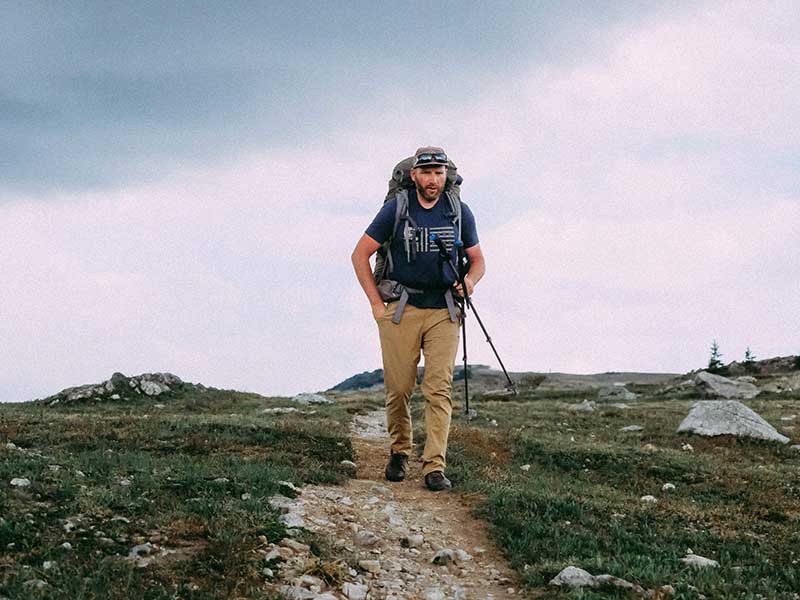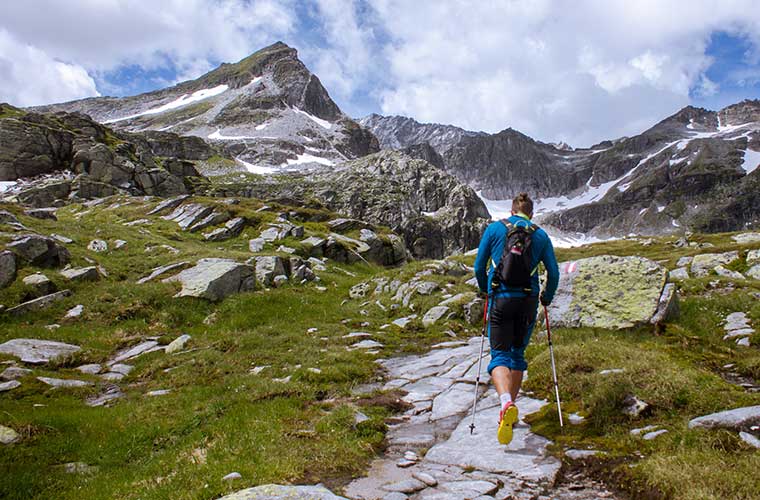Training for hiking: exercises

Summer is an ideal time for hiking, but you should not do it in an improvised way, both to avoid injury and to better enjoy the experience.
Carrying a heavy rucksack over difficult terrain requires a training previous.
Basic weekly training programme to prepare you for a 3-5 day trekking trip
Training should start about 12 weeks before your route(Remember that it is advisable to consult your doctor before you start practising sport and training like crazy).
For the design we assume a average physical condition. This programme is designed to improve your cardiovascular endurance, strength and ability to handle uneven terrain and slopes. The plan covers the first 4 weeks; the routine can be repeated with increases in intensity and duration for the following weeks.
Week 1-4: Training programme
Day 1: Cardiovascular Endurance Training
- Warming up: 10-15 minutes of light walking or jogging.
- Main training:
- 30-45 minutes of walking at a moderate pace on sloping terrain (hills or inclined treadmill if possible).
- Alternate 5 minutes of brisk walking with 2 minutes of slower walking to recover.
- Cooling: 5-10 minutes of stretching and deep breathing.
Day 2: Strength Training
- Warming up: 10 minutes of gentle jogging or brisk walking.
- Main training:
- Squats: 3 sets of 15 repetitions.
- Lunges (strides): 3 sets of 12 repetitions per leg.
- Step-ups (bench climbs): 3 sets of 15 repetitions per leg.
- Deadlift with dumbbells: 3 sets of 12 repetitions.
- Iron: Hold the position for 3 sets of 30-60 seconds.
- Cooling: 5-10 minutes of stretching focused on the legs.
Day 3: Active Rest
- Do a light activity such as yoga, swimming or a gentle walk for 30-45 minutes.
Day 4: Cardiovascular endurance training
- Warming up: 10 minutes of brisk walking.
- Main training:
- 45-60 minutes of walking in varied terrain (hills, stairs, etc.), if possible in an environment similar to that of your trek.
- Alternate 10 minutes of brisk walking with 3 minutes of slow walking to recover.
- Cooling: 5-10 minutes of stretching and deep breathing.
Day 5: Strength and Balance Training
- Warming up: 10 minutes of gentle jogging or brisk walking.
- Main training:
- Jumping squats: 3 sets of 12 repetitions.
- Heel raises (to strengthen the ankles): 3 sets of 15 repetitions.
- Lateral lunges: 3 sets of 12 repetitions per side.
- One-legged balance exercises: Hold the position for 30-45 seconds, 3 sets per leg.
- Gluteal bridge: 3 sets of 15 repetitions.
- Cooling: 5-10 minutes of stretching focused on the legs.
Day 6: Long walk
- Main training:
- Take a long hike of 1.5 to 2 hours on terrain as similar as possible to your hiking route. This hike is important to get used to long distances and to test your equipment.
- Cooling: 10 minutes of stretching and deep breathing.
Day 7: Rest or Active Rest
- Rest completely or do a light activity such as yoga, swimming or a gentle walk for 30-45 minutes.

Additional advice: the practice
An excellent form of training for trekking is also to do preparation walks. During the months before you start hiking, you should try to do a day hike every two weeks. In this way, you can develop better fitness, but also get used to the equipment you will have to carry.
- Progression: Each week, gradually increase the duration and intensity of training, especially on long walking days.
- Hydration and nutrition: Make sure you stay well hydrated and eat a balanced diet rich in complex carbohydrates, protein and healthy fats.
- Equipment: Practice with the equipment you plan to carry, including your backpack, to ensure that everything is comfortable and works well during the trip.
- Stretching: Spend time stretching after each training session to improve flexibility and prevent injury.
As the date approaches, the distances and the elevation of the terrain progressively increase, and so does the weight of the backpack. This is intended to allow you to gradually get used to what you will experience and as a "rehearsal" for what is to come.
In addition, this kind of practice will help you to be able to practising how to use the equipment you will be using while hiking and to be able to know what mountain clothing you will need, if you are missing anything for the trip, what the temperature is like in the area, etc.
Training for hikers planning to hike for a longer period of time

In case you are going to If you have to travel long distances and for more than a week, then your training is somewhat different from the previous one.. Hiking exercises corresponding to this type of route must be carried out between three and five days a week, starting at least 24 weeks before of the journey.
Moderate levels of steady state effort will be very important in this training because, although high intensity workouts are very popular at the moment, you must train to manage the energy you will use during your trek.
Your cardio workouts should last between 30 to 60 minutes. which should include a combination of walking/jogging and cycling or elliptical training to help you avoid injury from doing too much of the same exercise.
As for intervals, if you do five days of cardio, you need to include two higher intensity interval-focused workouts to build your anaerobic power for when you're pushing your pace or dealing with a steeper part of the road.
Start your interval workouts with a five-minute moderate-intensity warm-up (i.e., 4 to 5 on a scale of 1 to 10). Intervals should include 30 to 90 seconds of high-intensity work (8 to 9 on the intensity scale), followed by a light-to-moderate recovery period of up to two minutes. Continue this work-recovery ratio for 20 to 40 minutes and end your workout with a complete cool-down.
The importance of endurance training for a hiker

Once you start your trek, you will have a lot more activity than just walking. In a day you will have to fetch water, lift and put on your backpack, set up your tent, etc., so you will also need to do a lot more than just walking. endurance-strength exercises. Resistance training is key to preparing your body for the stability challenges and impacts of moving over uneven terrain.
How often should you do resistance exercise? Preferably two to three days a week and, of course, not forgetting cardio exercise. This type of training programme requires you to do resistance training on days when you do steady cardio and if you are not too fatigued. Of course, interval training should not be performed on the same days as endurance training.
On the other hand, remember that a warm-up is a must, and about five to ten minutes before resistance training. The warm-up should include two to five minutes of light aerobic activity, followed by two to five minutes of dynamic stretching. For example:
- Repeat 10 to 20 Steps ups with each leg.To do them, stand in front of a step or a bench between 30 and 60 centimetres high. Remember to fully extend your hips and keep your knees straight.
- Complete 10 to 20 repetitions of Heel Downs on each leg: Stand on a plyobox or bench and let the opposite foot hang over the side. Then, flex the free foot (toes up) and lower it to the floor. Concentrate on pressing your hips back as if you were sitting in a chair. Be sure to control the movement, letting your heel pass over the floor before returning to the starting position.
- Complete 10 to 20 repetitions of Rotating Upward Chop with each arm: Place a resistance band at a low point and grab both handles with both hands as you stand to lunge forward with one foot. There should be tension loaded through your torso and into your glutes.
- Do 10 repetitions of Lateral Pillar Bridge with hip movement: Start on your side with your elbow under your shoulder and your forearm perpendicular to your body. Stack your top foot on your bottom foot. Next, lift your hips up into a plank, creating a straight line from head to toe. Your whole body should remain aligned throughout the exercise. Slowly lower your hips down and then back up to the plank position, pressing against the floor with your lower forearm.
- 10 to 12 repetitions of Curl biceps with dumbbells in a front squat shoulder pressStand with feet shoulder width apart and hold a weight on each side in a neutral position. Press your hips back and squat down as if you were about to sit on an invisible chair. Keep your back and neck in a neutral position throughout the movement. Try to bring your thighs to the floor. As you drive your hips and torso upwards, use the upward momentum generated by your glutes to assist you as you drive the dumbbells upwards.
Don't miss any adventure in the Pyrenees!





